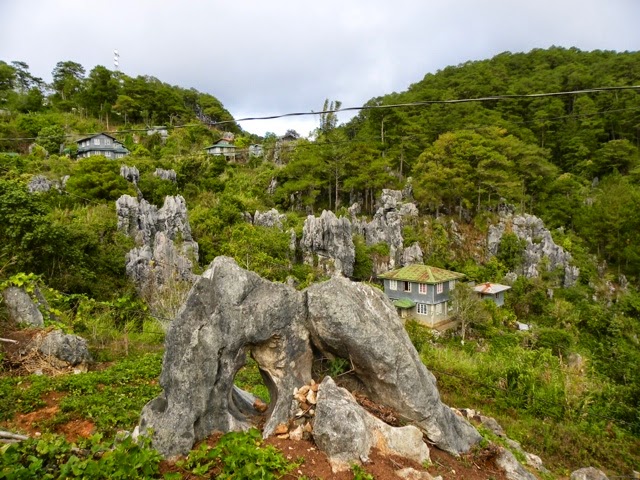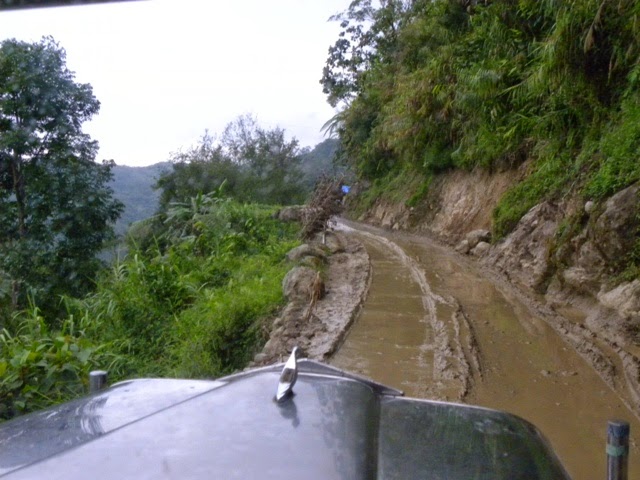We gave ourselves a late start and left Banaue at 9am. Our route to the little mountain town of Sagada took us through the Mountain Province and, as anticipated by the name, we drove through incredible mountain scenery. The one and only road was well established and maintained.
Ronnie couldn't resist showing his sense of humour (it's not really a drop-off) -
Bay-yo is one of many self-sustaining villages, each with their own terraces to grow rice and vegetables -
Bontoc, the capital of the Mountain Province, was merely a pit stop for fuel and a cash withdrawal. Trawling down the main street, I snapped the photo below through the van window. Momma? What is momma? In my last blog I mentioned that our guide Rusty chewed betel nut. Momma is the name given to the chewed-up discard. The natural bright red dye it contains leaves a stain wherever it falls and betel nut chewers tend to be indiscriminate as to where they spit. Municipalities throughout the Philippines are trying to clean up their streets, hence this sign. In the photo, the characteristic betel nut chewer with his missing front teeth appears to be mad.
Sagada Homestay turned out to be a cheap and cheerful place; we had our own room for P350/person (about $8/person) with a shared bathroom. Arriving there around lunchtime we ate quickly, then registered at the Tourism Information Office. They supplied a guide who could lead us to the famous hanging coffins and tell us a bit of the history. This was well worth the total price of P200 as he had a wealth of information and anecdotes.
The coffins are strangely fascinating if you consider they contain dead people and are hanging on the side of a cliff instead of being buried underground.
The location of the coffins is best understood with some perspective - the coffins in the above photo are the same ones at the bottom of the limestone pillar in this one:
Here's a photo of the surrounding area of Sagada showing some limestone pillars - note the one on the left-hand side in the middle distance that shows a patch of white ...
... I zoomed in on that particular pillar to find this! Fascinating!
Ironically, our walk to see the hanging coffins took us through the local cemetery. Apparently, not everyone likes hanging off a cliff once they're dead!
We left the guys in the marketplace and went for a walkabout around the town. Our first stop was the famous Lemon Pie shop. Time for a treat!
We couldn't understand why their tables and chairs were so small and didn't get the opportunity to ask. As we awkwardly sat down in the lilliputian chairs, I felt compelled to take a photo for the record.
And then it was time to walk off the calories! We decided to explore the 'suburbs'. A friendly dog had followed us earlier and surprisingly, had waited patiently for us to finish eating so that he could follow us once again. Notice the white dog in the photo above? He followed us for the next hour or so and only peeled off right at the end when we presume he headed home for dinner!
This was toward the end of our walk ... the dog still with us!
This viewpoint overlooked the town; our hotel is on the right-hand side higher up in the saddle -
And this is the view from our hotel room looking down toward the main area of Sagada -
It had been a pretty laid-back day as far as travel days go and we had energy to spare that evening to relax and socialize. Not that it was any warmer; I'm wearing four layers in this photo, Dennis three. If there was one more item I could have packed for this trip it would have been a warm beanie! There was nothing for it but to have a few drinks and try to ignore how cold we really were!
Once again, another wonderful day and very special to end it like this, amongst friends!
 | |
| Dennis, Karen, Ronnie, Rolly, Eduard & Alex |
Note on current exchange rate: USD$1.00 is about Philippine Peso P45 is about ZAR10.80




















































